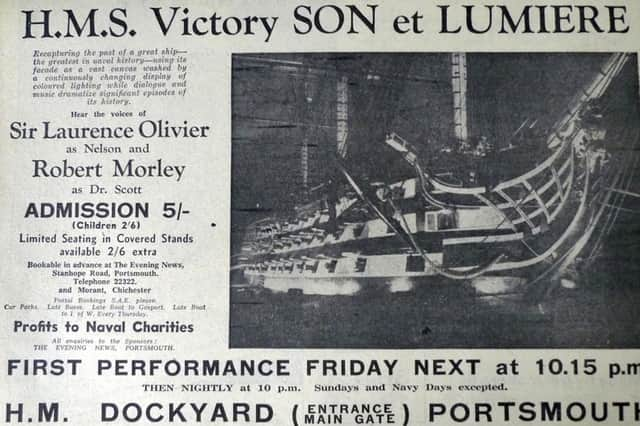NOSTALGIA: Broadsides flashed from Victory in Trafalgar re-enactment


Here are his memories of an unforgettable, and in those days cutting edge, son et lumiere held in Portsmouth Dockyard that summer against the backdrop of Nelson's flagship HMS Victory.
Â
Broadsides flashed from her gun ports, musket fire rippled from the upper decks and fighting tops and awful shrieks of pain mixed with gun captains' shouts to reload vented from every hatch amid the smoke and thunder of battle...
Advertisement
Hide AdAdvertisement
Hide AdThis time, nobody was killed or wounded as Trafalgar, October 21, 1805 was refought on board HMS Victory in a dramatic presentation that was only to be eclipsed by the 200th anniversary spectacular off Southsea in summer 2005.
Forty-five years earlier, battle raged every night at dusk from July to October when The Evening News sponsored a breathtaking nightly son et lumière with Victory Arena as the auditorium and Nelson's flagship as the stage and backdrop.
It was a battle '˜royal' in both senses of the word because the night I covered it as The Evening News' defence correspondent, I was sitting just behind King Gustaf Adolf and Queen Louise of Sweden, Admiral of the Fleet Earl Mountbatten of Burma and his daughter and son-in-law David Hicks and Lady Pamela Hicks to name a few of the VIPs who watched and applauded.
Add to that the awe-inspiring cast list, headed by Sir Laurence Olivier playing Lord Nelson and Robert Morley as Dr Scott (the admiral's peronal chaplain), whose voices were pre-recorded with the other prominent roles played by George Baker, Nigel Stock and David McCallum.
Advertisement
Hide AdAdvertisement
Hide AdTo complete the top quality performance, the music score was composed by Raymond Leppard and the production was by celebrated West End TV director Peter Wood.
The script was expertly written by Captain Jack Broome DSC RN, who commanded the escort flotilla during the disastrous PQ17 Arctic Convoy in 1942 and distinguished himself in retirement by writing books on naval subjects as well as being naval advisor for several films, including The Cruel Sea.
Son et lumière, invented in 1952 by Paul Robert-Houdin and first presented at French chateaux, uses recorded voices, narrative, sound and changing lighting effects to bring history to life in situ.
Preparations by today's standards of electronic, digital and laser effects were primitive, but at that time it was seen as new technology enhancing a gripping form of dramatic art.
Advertisement
Hide AdAdvertisement
Hide AdFlourescent tubes on dimmer controls were laid in No2 Dry Dock to illuminate Victory's hull, while directional lighting was produced by dozens of different types of incandescent lamps.
A battey of them was put up opposite on a storehouse roof and was used to pick out the ship's masts individually and collectively, as well as to pinpoint different scenes during the 40-minute action.
The 100 switches needed to operate the lighting display were controlled from an especially-built hut on the dockside.
And it certainly impressed the royal guests as the kaleidoscope of Nelson's and his flagship's finest hour unfurled before them.
Advertisement
Hide AdAdvertisement
Hide Ad'It was an excellent show. Thank you very much. It was wonderful,'Â I overheard King Gustaf comment to the C-in-C Portsmouth, Admiral Sir Manley Power.
The royal party had earlier attended a dinner in Nelson's cabin on board Victory and later returned with Lord Mountbatten to his home at Broadlands, Romsey.
With them they carried the souvenir eight-page special Evening News supplements to which I had contributed several articles.